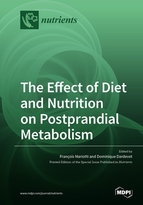The Effect of Diet and Nutrition on Postprandial Metabolism
A special issue of Nutrients (ISSN 2072-6643).
Deadline for manuscript submissions: closed (15 July 2019) | Viewed by 64709
Special Issue Editors
Interests: dietary protein and amino acids; cardiometabolic health; dietary quality; nutritional security
Special Issue Information
Dear Colleagues,
Humans feed themselves by discontinuous inputs that give an essentially dynamic characteristic to all nutritional processes. Metabolism is constructed according to a nutritional system: The individual's endogenous metabolism works on a fasting basis at a steady state to ensure physiological functions with consistency, but this situation results in molecule/nutrient losses that must be compensated for by ingestion. In the postprandial phase, conversely, the nutritional system must ensure the correct use of the influx of nutrients, by regulating flows while maintaining circulating concentrations within acceptable ranges. The postprandial phase is, therefore, the critical nutritional phase during which the body ensures its repletion while putting its hemostasis under pressure, and manages metabolic disturbance according to "hemodynamic" type processes. A decrease in good postprandial management capacity compromises the nutritional status of an individual, on the one hand, and, on the other hand, indicates alterations in metabolic health. The effectiveness of nutrient use in the postprandial phase appears to be a major determinant of long-term nutritional status for many nutrients. This efficiency is modulated by the characteristics of the diet, patterns of intake, nature of the meals, individual genetics, phenotypes and health status, and all other lifestyle characteristics. Changes in postprandial metabolism have been suspected to be potential early markers in pathophysiological course, leading to the risk of pathology. They are sensitive to diets and the complex nature of meals, which can alter the allostatic load, and postprandial deregulations are predictive of the risk of chronic diseases.
The purpose of this Special Issue is to expand and add to the research on the importance of postprandial metabolism in nutrition. In the transition period between fast and fed statuses, this issue seeks to cover the effects of diet, the nature of meals, and any nutritional characteristics, on meal nutrient metabolism and the ability to regulate metabolism in the postprandial phase. Associations with functional assessment criteria or risk factors can make a very interesting addition. The modulation of these phenomena by genetics and lifestyle is also interesting in this context. This issue welcomes the submission of manuscripts describing original research or reviews of the scientific literature on this topic in humans or animal models (rodents and pigs).
Prof. François Mariotti
Dr. Dominique Dardevet
Guest Editors
Manuscript Submission Information
Manuscripts should be submitted online at www.mdpi.com by registering and logging in to this website. Once you are registered, click here to go to the submission form. Manuscripts can be submitted until the deadline. All submissions that pass pre-check are peer-reviewed. Accepted papers will be published continuously in the journal (as soon as accepted) and will be listed together on the special issue website. Research articles, review articles as well as short communications are invited. For planned papers, a title and short abstract (about 100 words) can be sent to the Editorial Office for announcement on this website.
Submitted manuscripts should not have been published previously, nor be under consideration for publication elsewhere (except conference proceedings papers). All manuscripts are thoroughly refereed through a single-blind peer-review process. A guide for authors and other relevant information for submission of manuscripts is available on the Instructions for Authors page. Nutrients is an international peer-reviewed open access semimonthly journal published by MDPI.
Please visit the Instructions for Authors page before submitting a manuscript. The Article Processing Charge (APC) for publication in this open access journal is 2900 CHF (Swiss Francs). Submitted papers should be well formatted and use good English. Authors may use MDPI's English editing service prior to publication or during author revisions.
Keywords
- Postprandial metabolism
- Meal
- Energy and nutrient metabolism
- Dietary nutrient metabolic pathways
- Metabolic regulation








